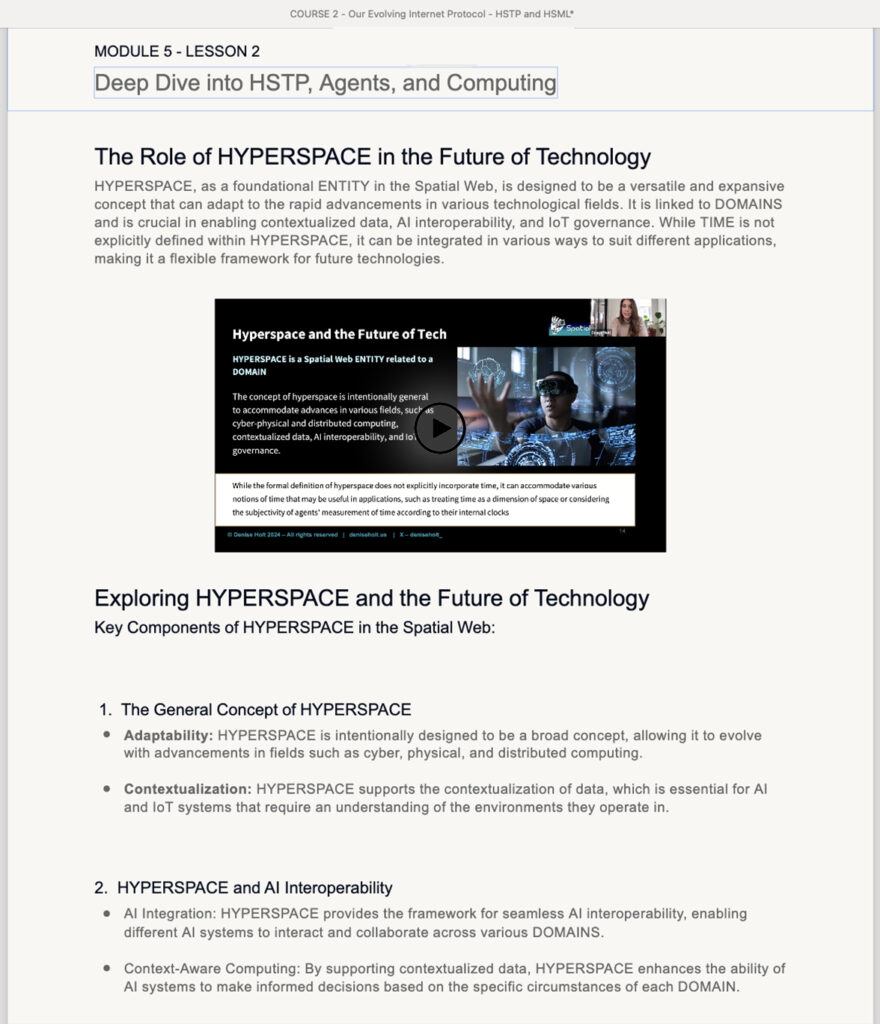Our Evolving Internet Protocol: HSTP and HSML
Enroll in this course to explore the evolution of internet protocols with a focus on the Spatial Web, introducing students to the core technologies and socio-technical standards like HSTP and HSML that enable secure, decentralized, and context-aware interactions across physical and digital spaces.


COURSE 2 - Our Evolving Internet Protocol: HSTP and HSML
This course explores the revolutionary advancements that make the Spatial Web possible. Students will gain a deep understanding of the Hyperspace Transaction Protocol (HSTP) and Hyperspace Modeling Language (HSML), the foundational elements that enable interoperability and seamless interactions between diverse systems, devices, and entities. Through this course, learners will explore how the Spatial Web unites digital and physical worlds, creating a secure, decentralized, and ethically governed ecosystem. Students will also examine the socio-technical standards that guide the Spatial Web’s development, emphasizing the balance between technical innovation and societal impact. By the end of this course, participants will be equipped with insights into the transformative potential of the Spatial Web, its ethical considerations, and its broad applications across industries like smart cities, autonomous systems, and digital identity management.
Course Outline:
Module 1: Introduction and Evolution of the Internet
This module introduces the Spatial Web Protocol, a framework that connects the physical and digital worlds through core components like HSTP, HSML, and the Universal Domain Graph. It explores the evolution of the internet from Web 1.0 to the Spatial Web, emphasizing secure, decentralized, and interoperable networks. This protocol enables seamless interactions and ethical governance, transforming how technology integrates with daily life.
Module 2: Foundations of Spatial Web Protocol
This module explains the foundational architecture of the Spatial Web Protocol, including HSML, HSTP, and the Universal Domain Graph. It highlights the protocol’s role in managing global data, enabling context-aware AI, and ensuring security and interoperability. Key principles like ownership, privacy, and ethical governance create a secure, interconnected framework for advanced technologies like IoT and smart infrastructure.
Module 3: Stakeholders and Socio-Technical Standards
This module explores the stakeholders and socio-technical standards shaping the Spatial Web. It identifies key stakeholders, including enterprises, communities, and global organizations, as well as their roles in governance and ethical development. These standards ensure the responsible and ethical evolution of the Spatial Web while addressing societal needs and compliance with legal frameworks.
Module 4: Advanced Concepts and Protocols
This module introduces advanced concepts and protocols of the Spatial Web, including multiscale cognitive computing, the Hyperspace Modeling Language (HSML), and the Universal Domain Graph (UDG). HSML enables seamless interactions by modeling legal, financial, and physical activities, while the UDG connects domains through a distributed hypergraph. The module explores hyperspace as a multidimensional framework for data representation, supporting dynamic interactions across digital and physical environments. These tools empower the Spatial Web to act as a collective nervous system, enabling intelligent, real-time decision-making and interoperability at scale.
Module 5: Deep Dive into HSTP, Agents, and Computing
This module provides an in-depth exploration of key components and protocols of the Spatial Web, including HSTP, agents, and computing frameworks. It covers how agents interact with domains and execute activities, governed by credentials, norms, and contracts to ensure secure, context-aware interactions. The module highlights HSML’s role in enabling efficient data queries and the Universal Domain Graph’s capacity to organize and interconnect entities. These tools combine to create a secure, interoperable, and dynamic digital environment where agents operate seamlessly across hyperspace and real-world domains.
Module 6: Practical Applications and Future Outlook
This module explores the practical applications and transformative potential of the Spatial Web Protocol. It highlights distributed computing, intelligent agents, and HSML-based channels as key tools for real-time collaboration and decision-making. Applications include warehouse robotics, urban digital twins, and decentralized AI systems that evolve collectively and adapt to local needs. By enabling a secure, interoperable, and decentralized framework, the Spatial Web Protocol paves the way for smarter, more efficient systems across industries and daily life.
Module Overview:

Sample Lessons:


Empower Your Future with Exclusive Certification


Lead the Next Era of Technology with Expertise in Active Inference AI and Spatial Computing
Earning certification through our courses on Active Inference AI and Spatial Web Technologies places you at the forefront of technological innovation. As the only educator and recognized authority in this groundbreaking field, I’ve designed these courses to provide unparalleled expertise and practical insights. Executive leaders who achieve certification gain a distinct advantage, positioning themselves as trailblazers in shaping the next evolution of intelligent, decentralized systems. In a rapidly changing technological landscape, this certification signifies your mastery and readiness to lead in the era of transformative AI and spatial technologies.
Successfully passing this course with a score of 80% or greater, earns you a Certificate of Completion for the course.
This Course is part of a 7 course Executive Certification Program to become a Certified Specialist in Active Inference AI and Spatial Web Technologies.

Explore the Courses:
Click on any course for an in-depth look…
© 2024 AIX Global Media All Rights Reserved.













